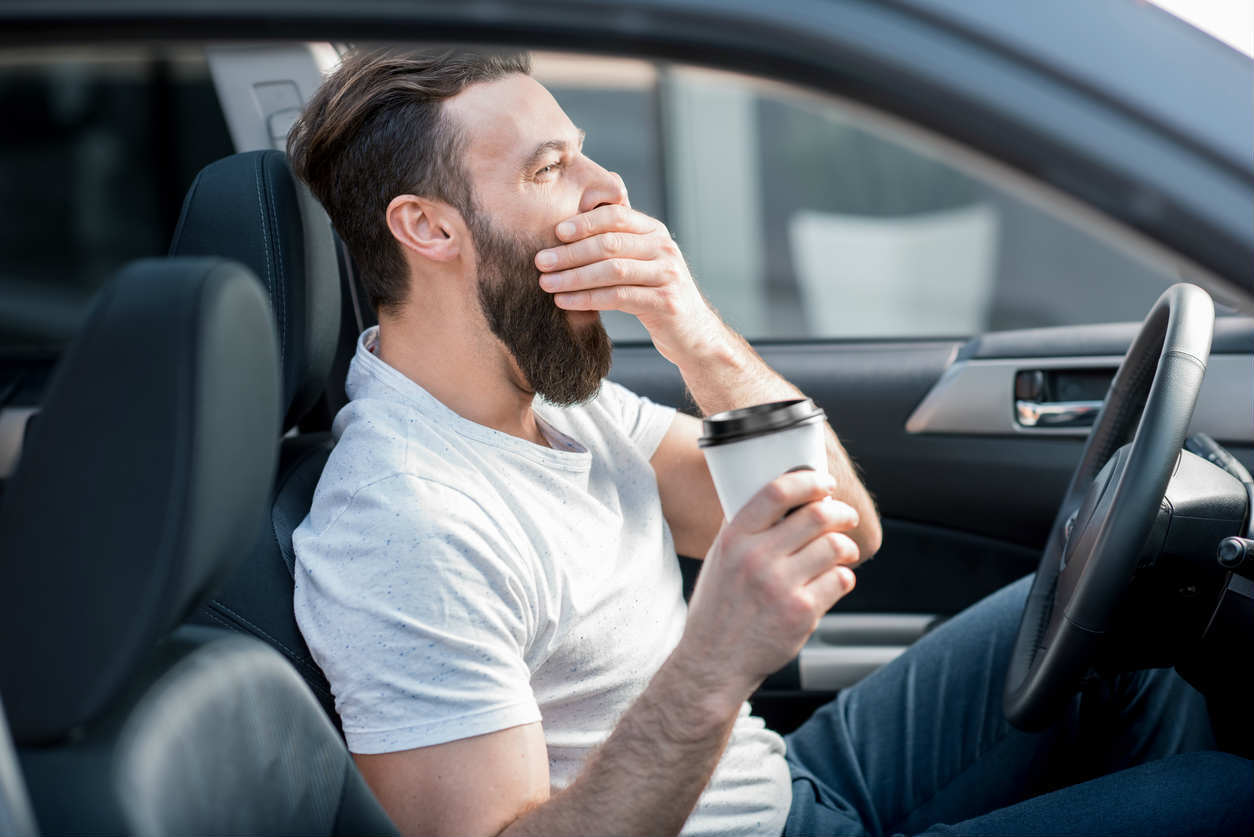The problem of drowsy driving has reached such levels that it now has become a common cause of motor vehicle accidents.
Recent reports published by the National Sleep Foundation & Governors’ Highway Safety Association (GHSA) have highlighted driving safety concerns arising out of fatigued driving.
Those who are drowsy while driving have a responsibility not to pose a risk to others. If a driver falls asleep while driving and causes a collision, any victims have certain legal rights.
Nation Sleep Foundation Survey
As scary as it might sound, in a survey by the National Sleep Foundation (NSF), about 60 percent of adult drivers owned up to driving a vehicle while feeling drowsy during the previous year. If that is not scary enough, about 37 percent (approximately 103 million American drivers) reveal they actually fell asleep while driving. The effect of insufficient sleep on the brain is similar to the effect of alcohol use. Another study found that lack of sleep for eighteen straight hours may produce similar effects as a 0.05 percent blood alcohol level (BAC). And a BAC level of 0.10 percent is equivalent to being awake for a complete twenty-four hours.

The likelihood of drivers who sleep about six to seven hours every night causing a crash is doubled, compared to those who sleep eight or more hours a night, according to the AAA Foundation for Traffic Safety. The situation is even worse in the case of drivers who sleep five or fewer hours a night. These drivers are about five times more likely to cause an accident. Driver fatigue is a major factor in about 100,000 accidents reported by police annually, according to the National Highway Traffic Safety Administration (NHTSA). More than 70,000 injuries and 1,500 deaths are said to result from such crashes.
GHSA Report Findings
The latest report from GHSA reveals that almost 83.6 million sleep-deprived Americans are driving their vehicles on U.S. roads every day. It is estimated that last year, 5,000 people were killed in drowsy driving accidents. Drowsy driving can occur among any drivers, but there are certain demographic groups that are more likely to be involved in a drowsy driving accident. According to available statistics, young adults and teens are involved in over 50 percent of the drowsy driving accidents occurring each year. Night shift workers, those who work long shifts, and those who work irregular shifts are also at greater risk. (Read – Night Shift Workers at Higher Risk) Drivers with sleep disorders are also at risk.
Some safety groups believe that these statistics do not reveal the actual scope of the problem. It is estimated that 2-20 percent of all fatalities are caused by drowsy driving accidents, which is a substantial discrepancy. Safety experts believe that it is difficult to gather accurate data because usually, law enforcement officers lack proper training to identify drowsy driving. Also, many people involved in crashes are afraid to reveal that drowsy driving was responsible for causing the crash.
Technology to Prevent Drowsy Driving
State Farm Insurance is working on wearable technology to prevent distracted and drowsy driving. They have recently patented a wearable device that is designed to alert motorists who exhibit the behavior of being tired or distracted. The alerts can be sent through smart watches, wireless headsets, or even clothes that have microprocessors fitted inside them. The device uses optic sensors to monitor a driver’s activities, such as how long the driver has been blinking and if his or her head nods.
Monitoring Driver Behaviors
This particular device could also be used as an alcohol sensor, thermal image capture device, or a heart rate monitor to measure whether the driver is sick, drunk, or unable to drive safely. The device could also keep a check on how often the motorist checks a mirror, as checking the mirrors too frequently could be a sign of distracted driving. It could also monitor behaviors and patterns and then suggest to the driver to have a caffeinated drink if they are drowsy and still have to drive.
The idea of using technology to keep drowsy or distracted drivers off the road certainly seems to be a great one; however, there are some valid criticisms as well. Many experts believe that it might not be as successful, because some drivers may not be willing to use a device to monitor their behavior just to get lower insurance rates. The technology may be of use to commercial drivers and fleet managers. Ultimately, the responsibility of safe driving lies with each driver and we cannot depend entirely on technology to eliminate risky behavior.
The Signs of Drowsy Driving
While it may not be possible to pinpoint the exact number of fatalities caused by drowsy driving, we know for sure that thousands of people are killed as a result of drowsy or fatigued driving. Since so many deaths result from drowsy driving, the NHTSA has altered the definition of impaired driving to accommodate fatigued driving as well. Impaired driving is now defined to include driving under the influence of drugs, drunk driving, and fatigued driving.
Here are some common ways to identify drowsy driving.
Yawning or Rubbing the Eyes Repeatedly
When the body requires sleep, it sends signals that can manifest in many ways. Yawning or rubbing the eyes repeatedly are two of the most common signals that a driver is fatigued. If you see a driver exhibiting these behaviors, it’s important to be cautious. Fatigued driving can lead to slower reaction times, impaired judgment, and even falling asleep at the wheel. If you’re sharing the road with a driver who appears to be fatigued, give them plenty of space and be prepared to take evasive action if necessary.
Drifting in and Out of Lanes
Another sign that a driver may be suffering from fatigue is drifting in and out of lanes. This can be a particularly dangerous behavior, as it increases the chances of a collision. If you see a driver repeatedly swerving or veering off course, take note and be sure to give them plenty of space on the road. In addition, keep an eye out for drivers who are hitting the rumble strips on the side of the road. These are all signs that the driver is not focused and may be at risk of nodding off behind the wheel.
Missing Exits or Sudden Lane Changes
Another way to tell if a driver is too tired to be on the road is if they start to miss exits or turn too late. A fully rested driver will generally take the exit they need without any problems. However, a driver who is starting to get fatigued may not notice their exit until it’s too late and may have to backtrack. This can cause delays and put other drivers at risk. Additionally, a driver who is too tired may not brake in time when making a turn, which can lead to an accident. If you see a driver making sudden lane changes or braking erratically, it’s best to give them a wide berth.
More signs:
- Difficulty keeping the head up or the eyes open
- Nodding off or falling asleep at the wheel
- Driving over the speed limit
- Following too closely behind other vehicles
If you see any of these signs, slow down and allow plenty of space between your vehicle and the one ahead, just in case the driver needs to stop suddenly. If possible, move into another lane.
It is important for all drivers to learn to recognize the signs of fatigued driving and to stop driving when they are not able to do so safely. If you continue to drive when you are fatigued, and you cause a collision, you may be held accountable for all the losses resulting from the accident.
Drowsy Driving Precautions
The most important thing you can do to guard against drowsy driving is to ensure that you get sufficient sleep before laying your hands on a steering wheel. You should make sure you drive only during the period you are most active and make plans for an overnight rest should the need arise. It is also advisable to rest every 100 miles or every two hours when going on a long journey.
It is equally important to make sure that you do not drink alcohol or any sleep-inducing medications, however little before you commence driving. It would be helpful to get a partner if intending to drive for a long distance. The two of you can take turns at the wheel and the other individual can help you stay awake when at the wheel. When driving alone, make sure you get your vehicle parked somewhere once you notice yourself becoming sleepy.
If you have become a victim of a car accident caused by a drowsy driver, contact The Hoffmann Law Firm, L.L.C. at (314) 361-4242 for a free consultation.
Why Choose Us vs TV Lawyers?
Direct Attorney Access
Maximum Settlement Focus
Trial-Ready Cases
Paralegal Handling
Quick Settlement Push
Settlement-Only Focus
Free Consultation with a St. Louis Car Accident Lawyer
Don’t talk to an insurance claims adjuster before speaking with The Hoffmann Law Firm, L.L.C. We can help you avoid making statements that may affect the outcome of your case. The consultation is free; you don’t pay unless we get you money!
